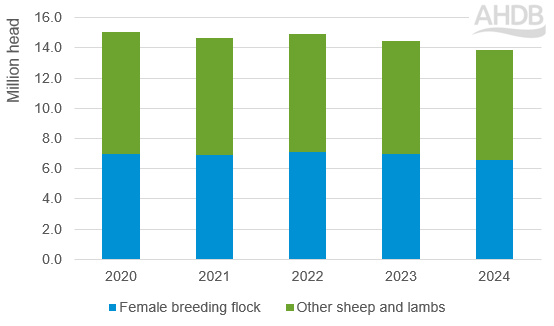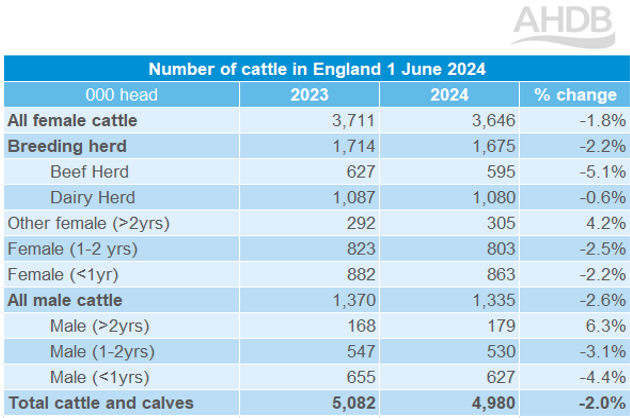Defra’s June survey confirms a further drop in England cattle and sheep populations
Friday, 13 September 2024
Defra’s annual June livestock survey reveals that sheep and cattle populations in England are at a record low, since the Defra census began.
Key points:
- The total sheep population declined by 4.3% year-on-year, now standing at 13.8 million head.
- The total cattle population saw a 2.0% reduction to 5.0 million head, driven by declines in the beef breeding herd.
- The most significant declines were seen in breeding female numbers, within both cattle and sheep populations.
Sheep
As of the 1st June 2024, the English sheep flock has experienced a 4.3% decline year-on-year, equivalent to a reduction of 620,000 head. This brings the total sheep population down to 13.8 million head.
Source: Defra
The total population decline was mainly driven by the breeding flock, which fell by 5.6% (390,000 head). Declines were also seen in the ‘other sheep and lambs category’ (-3.1%), this consists of lambs under 1 year old, rams and other sheep 1 year and over.
Most notably, there was a 11% fall in ewes intended for first time breeding. This is likely to be influenced by ewe lambs and shearlings slaughtered in the spring, incentivised by market conditions.
Number of sheep in England 1 June 2024
Source: Defra
The total female breeding flock now stands at 660,000 head, the lowest level since 2011. As a result, the lamb market outlook forecasts a decline of the lamb crop for the 2024 – 25 season (March - March).
The continued firm prices had raised questions as to whether stock has been held back this year, yet the Defra figures show that the population of lambs under 1 year of age declined by 3.5%. We await data from other devolved nations to further build an up-to-date UK picture.
Cattle
The Defra survey revealed a contraction in the total cattle population to 5.0 million head, 2% below the previous year and the lowest level in England recorded in the June survey. Pressure on margins and the recent robust beef prices are likely to have incentivised some culling.
The breeding herd fell by 2.2%, to total 1.7 million head. The dairy breeding herd saw a marginal decline of 0.6%. The beef breeding herd drove the decline, having fallen by 5.1%, accounting for 32,000 head. We anticipate these trends to continue from recent analysis.
Source: Defra
While male numbers over 2 years of age increased, overall, male cattle numbers declined by 2.6%. The decline of males under the age of 2 is likely to be linked to the changes in Dairy/Beef systems over recent years.
We will be completing detailed BCMS analysis, exploring beef trends in greater depth in the coming weeks.

Sign up for regular updates
You can subscribe to receive Beef and Lamb market news straight to your inbox. Simply fill in your contact details on our online form.
While AHDB seeks to ensure that the information contained on this webpage is accurate at the time of publication, no warranty is given in respect of the information and data provided. You are responsible for how you use the information. To the maximum extent permitted by law, AHDB accepts no liability for loss, damage or injury howsoever caused or suffered (including that caused by negligence) directly or indirectly in relation to the information or data provided in this publication.
All intellectual property rights in the information and data on this webpage belong to or are licensed by AHDB. You are authorised to use such information for your internal business purposes only and you must not provide this information to any other third parties, including further publication of the information, or for commercial gain in any way whatsoever without the prior written permission of AHDB for each third party disclosure, publication or commercial arrangement. For more information, please see our Terms of Use and Privacy Notice or contact the Director of Corporate Affairs at info@ahdb.org.uk © Agriculture and Horticulture Development Board. All rights reserved.




